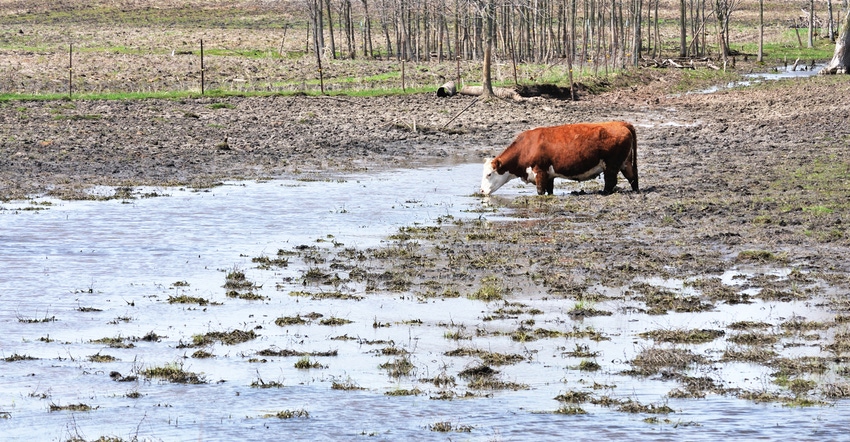March 21, 2019

Damage from trampling and pugging — when livestock break up the soil surface, burying or uprooting plants, especially in wet conditions — to pastures and feeding areas over the past several months has been extensive throughout Ohio.
For those who depend on pasture and forages for the foundation of their feeding program, the question that’s on many minds this spring is, “Do I need to reseed, and if so, where do I start?” Unfortunately, the response revolves around a lot of, “It depends.”
We’ve all had the experience of dealing with pugged areas in pasture fields. Seldom, though, has it been so widespread and extensive. Over the past several months the damage has been caused not only by repeated hoof action, but also rutting made by tractors as hay was delivered to the feeding areas over the winter.
The degree of damage will be variable and may call for different reactions throughout the farm, or even within a field. The course of action to repair these areas will be dependent on time and weather. Adding insult to injury as I write this, we’ve yet to have a window of more than a few days without precipitation, and pugged, trampled or rutted fields must dry before any repair work should begin.
How to proceed
As you consider a course of action, here’s a checklist and some suggestions:
Take time. Don’t get in a hurry to graze this spring, and perhaps add insult to injury by overpopulating or trampling fields that otherwise have been spared from this damage. Wait until soil conditions allow proper grazing management. This means short, quick grazing passes, thus preventing repeated hoof action on wet soils.
Wait until soils dry. For those fields that are already damaged, the highest priority now is to wait until soils dry out and are fit to work in. As difficult as it is, working on pugged and compacted soils while they remain wet deepens the damage and further delays the healing of pugged pastures.
Spread hay and manure where most needed. Piles of wasted hay and accumulated manure need to be removed and spread uniformly on the fields that most need the soil nutrients. If soil conditions don’t allow spreading now without compacting soils, hay and manure can be stockpiled for spreading later.
Use a harrow. In less-damaged areas, once soil conditions permit, pugged areas might simply be dragged with a harrow and allowed to regrow on their own. If there’s concern for the lack of roots for regeneration of previous forage species, clover or annual ryegrass might be overseeded in these areas at the time of harrowing.
Reseed with caution. If a total reseeding is being considered, keep in mind that spring — especially late spring — is not always the best time for grass seedings. These seedlings can be shallow-rooted and can struggle through summer heat due to weed competition, especially if precipitation is lacking.
Once early May arrives, if it’s been determined that a total reseeding is the best course of action, early to mid-August will be the best time to do this. This frequently leads to the question about how to manage these fields until then, and whether a temporary forage that might be available for grazing once or twice should be planted.
The short answer is yes, something should be planted to shade the weeds and allow some root growth for the benefit of damaged soil structure. However, if it gets late, and the goal is to destroy what you might start in the spring in time to reseed in August, it’s difficult to justify spending much money on seed now for a temporary seeding. Carefully consider the cost versus the realistic potential for plant yield and harvest between the time of planting and early August.
Check soil fertility when possible. Note, little has been said about fertility. If cattle have been wintered in an area, it’s likely the nutrients from manure and urine that have been trampled into the soil are abundant. At best, it will be a challenge at this time to acquire a representative soil sample for testing anyway.
Plant something. If a temporary seeding can be planted by early May, annual ryegrass plus some oats is an option. If it can’t be planted until later in May or even early June, crabgrass is a consideration. I’m often asked about sorghum-sudangrass or sudangrass. While these are excellent choices for a summerlong annual forage that would allow multiple harvests, it’s a challenge to harvest enough forage to recover the costs of seed and nitrogen when the goal is to destroy it Aug. 1 to make a new seeding.
If you simply smooth up the damaged area when soil conditions permit and don’t plant anything, weeds like pigweed, barnyardgrass, jimsonweed, goosegrass and ragweed will fill in until they are destroyed later in the summer. The root action from these plants will be good for the soil, but these plants must be prevented from making seed.
Have I mentioned waiting until soil moisture conditions permit before beginning a pasture reclamation project? Even though the ground equipment might not be making a visible track, wet soils below the surface are being compacted to the detriment of any future root growth.
Recovery from one of the wettest years on record will be neither easy nor rapid on Ohio beef cattle farms in 2019. Be patient and be sure you make the repairs correctly — the first time.
Smith is a program assistant in the Fairfield County Ohio State University Extension office and a member of the OSU Extension Beef Team. The Beef Team publishes the weekly Ohio BEEF Cattle letter. See the letter at beef.osu.edu.
About the Author(s)
You May Also Like




